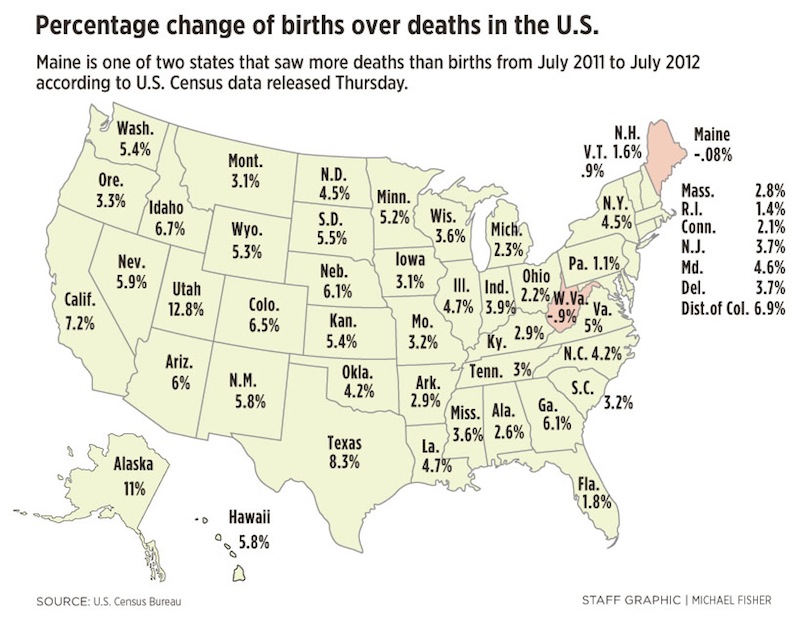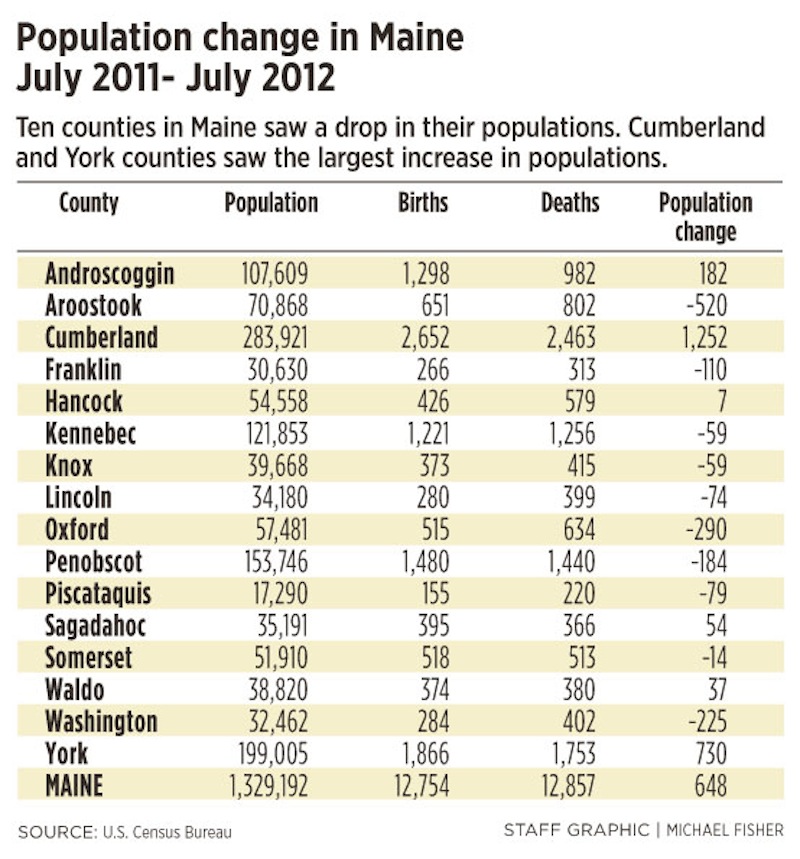WASHINGTON — The number of deaths in Maine is on pace to eclipse the number of births for the second straight year, a trend that could have implications for the state’s economy.
U.S. Census data released Thursday shows that from July 2011 to July 2012, deaths in Maine outnumbered births, 12,857 to 12,754.
Those numbers likely will be adjusted, but they highlight Maine’s status as one of the nation’s oldest states and that families appear to be having fewer children.
The 2011 calendar year was the first in at least 70 years in which more people died in Maine than were born here, according to data from the state’s Office of Vital Records.
The new census figures suggest that when the state numbers for the 2012 calendar year are complete, they will show the trend continuing.
To some extent, the phenomenon is a national problem, though it’s most obvious in Maine and West Virginia – the only other state where deaths exceeded births from July 2011 to July 2012.
However, 1,135 of the nation’s 3,143 counties, more than one-third, are now experiencing what economists call a “natural decrease.” That’s up from roughly 880 U.S. counties, about one-quarter, in 2009.
Eleven of Maine’s 16 counties had natural decreases from July 2011 to July 2012, with the largest percentages in Washington and Piscataquis counties.
State Economist Amanda Rector said the natural decreases are an economic challenge for the state.
“Population growth is directly related to economic growth,” she said. “Businesses that want to move here or expand need to be able to fill their work force needs.”
Ryan Neale, program director for the Maine Development Foundation, said finding enough able-bodied workers to fill jobs is a major challenge in the state. And that’s unlikely to change, he said, given Maine’s aging population.
More likely, Neale said, the solution will entail bringing in workers from other states or countries.
“We have a lot of desirable qualities as a state, but people need to be assured that they can find a career here,” he said.
Data from the Office of Vital Records shows that Maine’s birth rate has ebbed and flowed, going up sharply during the baby boom from 1946 to 1964, then falling throughout the 1970s, before experiencing a smaller boom in the late 1980s.
From 1990 through 2002, the number of births in Maine dropped steadily, falling from 17,314 to 13,549. Beginning in 2002, the rate went back up, reaching a high of 14,152 in 2006.
But the number has decreased every year since, dropping a full 10 percent in the period from 2005 through 2011.
The 12,694 births in 2011 was the lowest yearly total on record, dating back to 1940.
Rector, the state economist, said families often put off having children in times of economic turmoil. History shows that once economic conditions improve, birth rates rise, sometimes dramatically.
Meanwhile, Maine’s death rate has gone up gradually in the last three decades. From 1950 to 1980, the number of deaths per year averaged about 10,500. From 1980 through 2010, the yearly average was closer to 12,000.
Deaths overtook births in 2011, and that trend could continue as 70 million baby boomers nationwide grow older.
Liz Thompson, program coordinator for the Southern Maine Agency on Aging, said a recent census study showed that from 2008 to 2020, the number of people 65 or older in Maine is expected to increase by 51 percent.
“We’re seeing greater demand for services, particularly inquiries about Medicare,” she said. “There doesn’t seem to be an end in sight.”
Despite increasing deaths, the U.S. population as a whole continues to grow slightly. In Maine, the population increased by 648 residents from 2011 to 2012, less than 0.05 percent.
While population growth is stagnant, the data reveals a continued shift away from rural counties and toward metropolitan centers.
The new census figures show that 10 of Maine’s 16 counties lost population from July 2011 to July 2012, with Aroostook, Piscataquis and Washington counties losing the most by percentage.
All six counties that had population increases were in southern or coastal Maine, with Cumberland and York counties gaining the most people.
Scott Moody, an economist and the director of the Maine Heritage Policy Center, wrote a blog post about Maine’s lackluster population growth, which he called “demographic winter.”
“As net natural population growth moves further into negative territory, it will eventually reach a point where even net in-migration will not be able to compensate,” Moody wrote.
Rector said population shifts will always be dictated by jobs.
The expansion of technology-related industries has made it easier to do some jobs from anywhere, she said, but some areas of Maine still have infrastructure deficiencies that limit that ability.
Eric Russell can be contacted at 791-6344 or at:
erussell@pressherald.com
Twitter: @PPHEricRussell
Send questions/comments to the editors.





Success. Please wait for the page to reload. If the page does not reload within 5 seconds, please refresh the page.
Enter your email and password to access comments.
Hi, to comment on stories you must . This profile is in addition to your subscription and website login.
Already have a commenting profile? .
Invalid username/password.
Please check your email to confirm and complete your registration.
Only subscribers are eligible to post comments. Please subscribe or login first for digital access. Here’s why.
Use the form below to reset your password. When you've submitted your account email, we will send an email with a reset code.